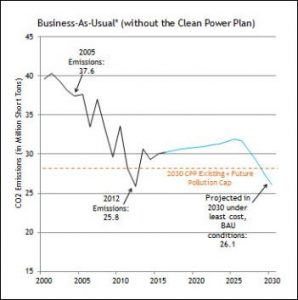
With least cost planning, says the NRDC, Virginia would continue to sufficiently reduce carbon emissions, in absence of Dominion’s IRP proposal.
by James A. Bacon
The 15-year planning document filed by Dominion Virginia Power last week vastly overstates the cost of complying with the Clean Power Plan and is chock-full of errors, flaws and misjudgments, charged Walton Shepherd, staff attorney for the National Resources Defense Council (NRDC) and a member of a committee of stakeholders advising the McAuliffe administration on how to comply with the plan, should it meet federal court approval.
“Dominion’s IRP … outlines a gargantuan, $13 billion energy plan to reduce total carbon pollution that asks its customers to pay for a Ferrari, when it already has a finely tuned car that can safely — and more affordably — get everyone to the store and back in time for dinner,” wrote Shepherd.
In a blog NRDC post yesterday, Shepherd cited three major flaws in Dominion’s analysis.
- Dominion’s $12.8 billion dollar building plan assumes that it will have to replace electricity generated by every single one of its coal-fired plants. That’s not true, he said. As a result of previous initiatives undertaken before the announcement of the Clean Power Plan, Virginia “has already achieved so much of its compliance obligation that it would likely make the carbon reductions required by the Clean Power Plan even in absence of the federal regulations.”
- Dominion disregards the existence of the interstate electricity grid — the company is part of the PJM regional transmission organization — which allows it to tap into wholesale electricity markets. “That national grid, which of course includes all of Virginia in its continent-wide footprint, is precisely why Dominion doesn’t need to build new plants: transporting cheaper and cleaner electricity from elsewhere was the entire point of building out our vast and sophisticated transmission network.”
- Dominion’s plan overlooks the obligation by Virginia regulators to find the least-cost measure to meet customer needs. “Robust analysis of the CPP shows the compliance costs for the entire region (of VA, WV, PA, OH, and NJ) to reduce carbon pollution from existing and future power plants could be less than one-fifth of Dominion’s cost of $13 billion, which is a price tag for Virginians to pay alone.”
Bacon’s bottom line. The first point requires some explanation for readers not intimately familiar with this debate: That $13 billion price tag is Dominion’s estimate for what it says is the most expensive of the four Clean Power Plan compliance strategies (so-called Plan E) on the table — the plan preferred by Shepherd and the NRDC. It would impose a mass-based cap on carbon dioxide emissions from Virginia’s fossil fuel-fired generating fleet, including existing and new facilities — 27.43 million short tons of CO2 in 2030 and beyond.
To achieve that goal, Dominion maintains that it would have to go beyond the currently planned shutdown of oil-fired Unit 3 at Yorktown Power Station, coal-fired Units 3 and 4 at Chesterfield Power Station, and both coal-fired units at Mecklenburg Power Station. Dominion’s econometric modeling suggests that Plan E would require the shut-down of Units 5 and 6 at Chesterfield, both units at Clover Power Station by 2022, and the Virginia Hybrid Energy Center by 2029.
Shepherd is contesting that assertion. He is saying that simply following existing policy, which shuts down coal-fired units to meet the toxic-emission standards issued earlier this decade, got Virginia below the mass-based level at temporarily in 2012, and that it would take only modest effort to keep it below that level through 2030. (See the chart above.) This appears to be a fundamental disagreement in analysis with Dominion.
On the second point: Dominion’s 2016 IRP does indeed glide over discussion of purchasing power on the wholesale markets. One of the advantages to participating in a regional electric grid is that it is easier to balance electric-generating sources, especially variable sources like wind and solar, over a larger geographic area. PJM has said that the system should be able to accommodate as much as 30% renewable power without jeopardizing grid reliability.
However, Shepherd’s understanding of how the PJM grid works differs from mine. It is not a vehicle that Dominion can tap to import vast supplies of renewable energy. Some renewable energy, yes, but not limitless amounts. First, there are transmission constraints. There is a limited number of transmission lines with a finite amount of capacity, which cannot be exceeded without incurring significant congestion charges and creating reliability issues. Second, Dominion cannot simply be an electricity taker. It has to be able to feed power into the regional grid as well in order to help maintain the regional balance. Perhaps Dominion could purchase more electricity off the regional grid, but it’s not clear how much more.
On the third point: Dominion says compliance will cost $12.8 billion, NRDC says it will cost one-fifth that amount for Virginia and nearby states. Dominion has its econometric model; NRDC has its own econometric model. Without knowing the inputs and constructions of each model, it is impossible for disinterested citizens to know which is a more accurate representation of reality.


